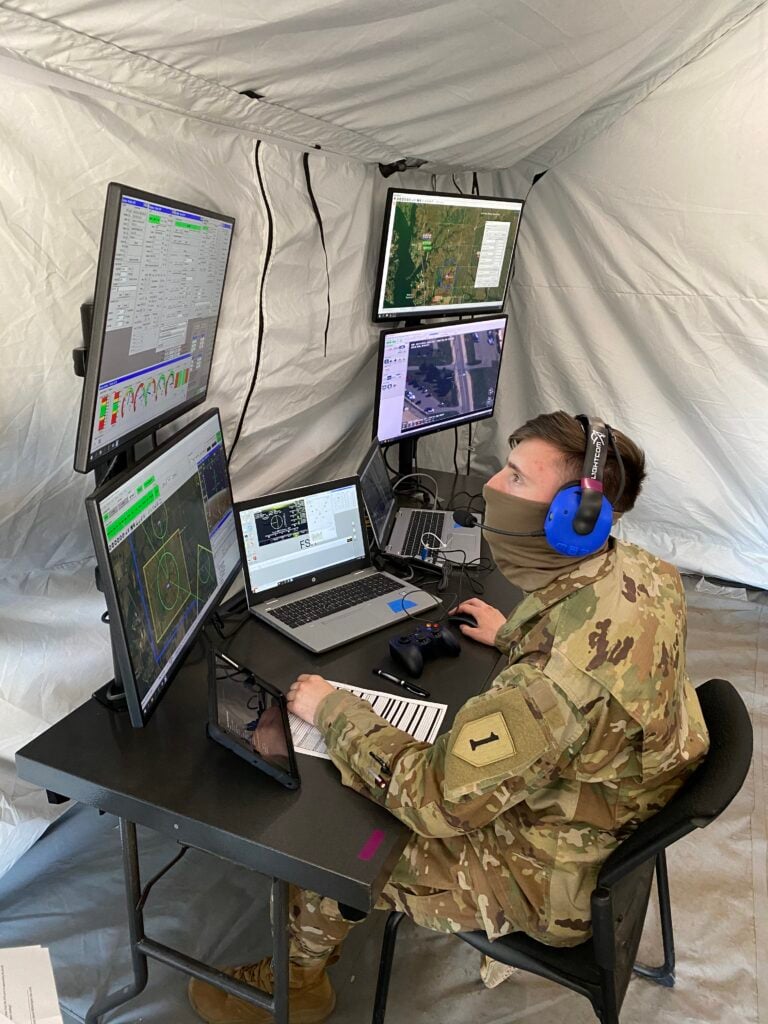
Spc. Christopher McCoy starts the engine on the new JUMP 20 drone as his brigade begins field trials.
WASHINGTON: First Infantry Division soldiers at Fort Riley, Kansas launched their first Arcturus JUMP 20 recon drone on Tuesday, one of four UAVs the service is evaluating to replace the aging RQ-7 Shadow. While some high-profile weapons testing has been delayed or disrupted by the COVID-19 coronavirus, from the F-35 fighter to the IBCS missile defense network, the 1st ID’s commander, Maj. Gen. John Kolasheski, okayed the Future Tactical Unmanned Aerial System (FTUAS) test — with some precautions.
“1st Infantry Division Soldiers are encouraged to wear cloth face coverings in public settings or in situations such as the FTUAS assessment, where social distancing is difficult,” said Maj. John Allen. “Our actions to protect the force and prevent the spread of COVID-19 are continually assessed and revised as necessary and in accordance with Army policy.”

Army Specialist Nicholas Miller wears a cloth mask as he remote-controls a new JUMP 20 drone during field tests.
Allen is public affairs officer for the division’s 1st Armored Brigade Combat Team. The unit, one of the oldest in the Army with a history going back to World War I, is now the first of five combat brigades that will be field-testing the four FTUAS contenders. The Martin V-Bat, Textron Aerosonde HQ, and L3Harris FVR-90 will each be tested by a different brigade, while two units (including the 1st ABCT) will try out the largest of the drones, Arcturus UAV’s 210-pound JUMP 20. The exact start dates are now uncertain as each unit and contractor must take precautions against the pandemic.
This multi-month, multi-brigade effort is part of Army Futures Command’s emphasis on getting feedback from real soldiers early in acquisition programs, rather than trying to perfect new technology in isolation from the people who’ll actually have to use it.
So far, so good, according to soldiers quoted in today’s Army announcement. The current Shadow drone is so loud that “we’re used to screaming at each other and having to use radios in order to communicate,” said Spc. Christopher McCoy. With the JUMP 20, he said, “you can stand right next to this aircraft and not even raise your voice.”
Getting a quieter scout drone is a top priority for the FTUAS program – not to save soldiers’ hearing, although that’s a positive side effect — but to make it harder for enemies to detect.
Another priority is scrapping the cumbersome infrastructure required for the Shadow, which needs a pneumatic catapult to launch it and a runway to land on. “With the VTOL [Vertical Take Off & Landing] system on the JUMP 20, we don’t need any of that,” said Spc. Nicholas Miller (pictured above in his cloth mask). “We’re working with half the equipment.”
The 1st Brigade will try out the JUMP 20 for five months, building up from this week’s familiarization drills to full-scale brigade wargames at the National Training Center – assuming, that is, that those exercises aren’t canceled by the pandemic like so many others.
In a ‘world first,’ DARPA project demonstrates AI dogfighting in real jet
“The potential for machine learning in aviation, whether military or civil, is enormous,” said Air Force Col. James Valpiani. “And these fundamental questions of how do we do it, how do we do it safely, how do we train them, are the questions that we are trying to get after.”


























